Tags
Austria, bucket, burning building, church, fire, firefighter, Florian cross, Hall in Tirol, Krakow, Maltese cross, Maria Alm, martyr, millstone, Poland, relic, Saint Florian, Salzburg
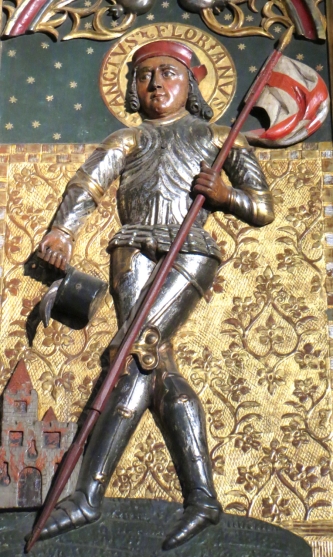
St. Florian (detail), Altarpiece, Strasbourg Cathedral
Images of a knight serenely dousing a burning building with a bucket of water have mystified generations of travelers journeying through Europe.[1] The knight can be found atop pillars in city squares, emblazoned on buildings, and perched beside church altars. Depictions of the knight, identifiable as Saint Florian, are particularly common in central Europe, where he continues to be honored and venerated to this day. I have even encountered his statue in a Salzburg hotel calmly quenching a fire with a telltale bucket and have wondered at his likeness on a fire extinguisher in the sleepy town of Maria Alm, Austria. Why does Saint Florian carry a bucket? What is the meaning of the burning building at his feet? And why is he so popular in central Europe?
Who Was Saint Florian?

Saint Florian was a Roman army officer who held an administrative post in Noricum, a Roman province that included what is now Austria.[2] In 304, during the Christian persecutions of the emperor Diocletian, Saint Florian publicly revealed he was a Christian and was subsequently tortured and killed for his faith.[3] According to the Passion of Saint Florian, Florian encountered soldiers with whom he had previously served as he approached Lorch (Lauriacum). When he asked where they were going, they responded, “Have you not heard the emperor’s commands which reached the praeses, in accordance with which he orders all men to offer libations to the gods, and that those who refuse should be put to death by various means?”[4] Florian answered, “Brother and fellow soldiers, what else do you need seeing that I am a Christian? Go and tell the praeses that I am a Christian and am here.”[5]
The soldiers were skeptical of Florian’s surprising confession, but they dutifully arrested him and brought him before the governor, Aquilinus, who first encouraged and then ordered Florian to offer sacrifice to the gods to prove he was not a Christian. When Florian refused, the governor ordered him beaten with clubs. Florian replied, “Be as angry and do as much harm as you can, since you possess power over my body which has been given to you for now. If you want to know why I do not fear your tortures, light a fire, and I will climb upon it.”[6]
According to various sources, Florian was beaten with clubs, was “twice scourged, half-flayed alive and finally thrown into the river Enns with a stone around his neck.”[7] Because he was martyred by drowning, Saint Florian is often invoked as a protector against drowning or against danger from water, including flooding. He is also frequently portrayed in art with a millstone around his neck or in close proximity.
Patron Saint of Firefighters
Saint Florian is also recognized as the patron saint of firefighters, although the reason for his association with firefighting is unclear. Some commentators have tried to link the origin of the tradition to his martyrdom, although Saint Florian was not recognized as a protector against fire until much later. Florian’s association with firefighting likely derives from a legend that arose in the Middle Ages, a legend that also explains why he is commonly portrayed with a bucket and a burning building.

St. Florian, Waldauf Chapel, Hall in Tyrol
Explanations tracing Saint Florian’s patronage of firefighters to his martyrdom seem improbable, particularly since they involve some manipulation of the historical sources. A number of online sources claim that Saint Florian’s executioners initially intended to burn him at the stake, but Saint Florian told them, “If you do, I will climb to heaven on the flames.”[8] At this, they grew uneasy, and they decided to beat him instead before ultimately drowning him in the Enns.[9] While this version of the story may sound compelling, it is not entirely consistent with earlier versions of Saint Florian’s “acts.”
As noted in the Passion of Saint Florian, above, Florian did tell Aquilinus, “light a fire, and I will climb upon it,” but he made no reference to rising to heaven either on its smoke or flames as some online sources suggest. These sources tend to misquote the Passion and unintentionally shift the focus of Florian’s words from his faith in Christ to his faith in his own apotheosis. Florian invoked the image of a pyre to affirm his Christian beliefs and to demonstrate his willingness to suffer torture for it, not as gasconade. The Acta Sanctorum similarly places Florian’s statement in this context.[10] In it, Saint Florian had already been beaten “for a long time,” when he turned to Aquilinus and said, “You have power over my body, but not over my soul. So do whatever harm you can, since no way will I submit to your commands. In order that you may learn that I do not fear your tortures, order a strong fire to be lit, and, in the name of my God, I will walk upon it without harm.”[11]
Modern commentators appear to be reaching for a link between Saint Florian’s martyrdom and his status as a protector against fire. However, because Saint Florian did not become identified with firefighting until centuries after his death, during the late Middle Ages, it is unlikely the circumstances of his death precipitated the tie to firefighting.[12]
Bucket Brigade
 Most representations of Saint Florian depict him dressed as a Roman soldier or a medieval knight holding either a banner or sword in one hand, a bucket or pitcher in the other, with a burning building, city, or church at his feet. Alternatively, as mentioned above, he may be shown with a millstone, the instrument of his death. According to a catalogue published by the Metropolitan Museum of Art, Saint Florian first appeared with a bucket and a burning building in the late 15th century.[13] According to legend, Saint Florian managed to save a burning house – sometimes it is as an entire city – with a single bucket of water.[14] Florian’s reputation as a protector against fire earned him great devotion in medieval society, which lived in constant fear of fire and the threat of urban conflagration.
Most representations of Saint Florian depict him dressed as a Roman soldier or a medieval knight holding either a banner or sword in one hand, a bucket or pitcher in the other, with a burning building, city, or church at his feet. Alternatively, as mentioned above, he may be shown with a millstone, the instrument of his death. According to a catalogue published by the Metropolitan Museum of Art, Saint Florian first appeared with a bucket and a burning building in the late 15th century.[13] According to legend, Saint Florian managed to save a burning house – sometimes it is as an entire city – with a single bucket of water.[14] Florian’s reputation as a protector against fire earned him great devotion in medieval society, which lived in constant fear of fire and the threat of urban conflagration.
Representations of Florian as a firefighting saint quickly gained popularity, particularly in Austria and southern Germany. In the region even today, Saint Florian has become so synonymous with firefighting that his image is readily used to identify fire stations and departments. The exteriors of firehouses frequently feature an image of Saint Florian on a wall or a statue of Saint Florian tucked into a niche. The name “Florian” even serves as a universal radio call sign for Feuerwehr (fire department) vehicles and stations.
The Florian Cross

Beyond Austria and Germany, Saint Florian’s influence on firefighting may be less conspicuous, but it is still discernible. Many fire departments incorporate what has come to become known as a “Florian cross” or “cross of Saint Florian” into their badges, patches, and other organizational emblems. The cross features four triangular arms, of equal length, that are rounded at each terminus and that taper toward the center. (An example is depicted at left, courtesy of Wikimedia Commons.) Often confused with the Maltese cross, which has no curved lines, the origin of the Florian cross’s design remains obscure.[15] Many commentators have argued that the Maltese cross, which the Knights of Saint John famously wore to identify members of their order, became a symbol of firefighters because firefighters, like the earlier knights, were willing to lay down their lives to protect others.[16] While this explanation may sound plausible, it ignores the fact the Florian cross is simply not a Maltese cross.[17]

Alternatively, the Florian cross may have evolved from a Maltese cross over time. (An example of a Maltese cross is depicted at left, courtesy of Wikimedia Commons.) Many cross variations share similar features, and it is possible the Maltese cross gradually developed into a Florian cross over the course of several centuries. A comparison of the two symbols – one featuring relatively thin, angular arms, the other comprised of broad, curved arms – suggests, however, that such a radical metamorphosis is unlikely to have occurred. Another explanation is that the Florian cross is sui generis – though possibly inspired by the Maltese cross.
The various representations of Saint Florian I’ve examined, mostly from the medieval period, offer no clues to the cross’s origin. Occasionally, Saint Florian is portrayed holding a banner emblazoned with a cross, but the cross it features is invariably a simple Latin cross. In at least early representations of Saint Florian, the saint does not appear to wear or carry the symbol that has come to bear his name. On the other hand, many protective medals and medallions featuring Saint Florian are shaped in variations of the Florian cross, with broad, curved arms enclosing an image of the saint. Could the shape of early Saint Florian medallions have inspired the outline of the Florian cross? Perhaps it’s a question of the chicken or the egg, and ultimately, I do not know how the Florian cross came to be. My guess is the design derives from the late 19th century, since that appears to be when fire departments began to incorporate a cross into their emblems.[18]
The Relics of Saint Florian and the Royal Road
In addition to serving as the patron saint of firefighters, Saint Florian is also the patron saint of various localities, including Linz, Austria; the state of Oberösterreich (Upper Austria), Austria; and Poland.
According to legend, after Florian was drowned in the Enns, his body was recovered by a devout woman named Valeria and was buried. His body was eventually transferred to the Augustinian Abbey of Saint Florian, near Linz.
 In 1184, Pope Lucius III sent relics of Saint Florian to Duke Kasimir the Just of Poland. Kasimir had the relics sent to Krakow, one of Poland’s oldest and most important cities. According to tradition, the horses carrying the relics stopped in Kleparz, a medieval suburb of the Cracow, before reaching the city gate and refused to continue any further. Their obstinacy was interpreted as a sign, and the church of Saint Florian (pictured above) was erected on the spot to house the relics.[19]
In 1184, Pope Lucius III sent relics of Saint Florian to Duke Kasimir the Just of Poland. Kasimir had the relics sent to Krakow, one of Poland’s oldest and most important cities. According to tradition, the horses carrying the relics stopped in Kleparz, a medieval suburb of the Cracow, before reaching the city gate and refused to continue any further. Their obstinacy was interpreted as a sign, and the church of Saint Florian (pictured above) was erected on the spot to house the relics.[19]
After the capital was moved from Krakow to Warsaw, the church of Saint Florian became the receiving point for the bodies of deceased royalty, who continued to be buried at Krakow’s Wawel Cathedral. Royal funeral processions followed what became known as the Royal Road or Royal Route, a course replete with references to Saint Florian. The route originated at the church of Saint Florian, passed through the 14th century Florian Gate with its polychrome figure of Florian extinguishing a gilded fire, and continued along Floriańska Street before reaching the Main Market Square. From there, the route wound through the Old Town, past the Church of Saints Peter and Paul, to Wawel Hill and its looming cathedral.
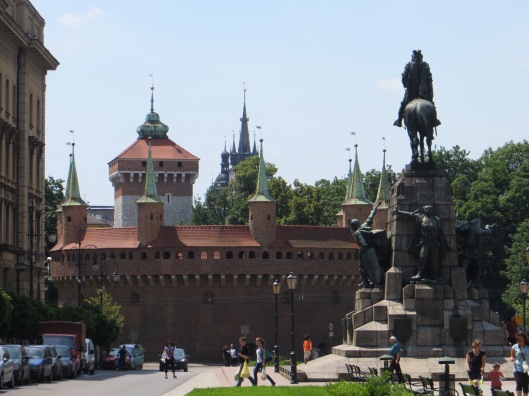
The Royal Road with the tower of the Florian Gate at left
May I Propose a Toast . . .
Shortly after returning from a trip to southern Austria, I stumbled upon this passage from the correspondence of John Lothrop Motley, a 19th century American historian. Written almost 179 years earlier, I was struck by how, in some ways, very little has changed since Motley’s own travels through the region. On the other hand, I was surprised to learn of Saint Florian’s apparent standing as the patron saint of innkeepers and brewers. Motley writes:

Maria Alm, Austria
“Among other Catholic images which are strewed all along the roadside, one in particular puzzled me for a long time—the figure of a saint in armour with a sword in the right hand and a bucket of water in the left, which he is emptying on a burning house. I have found that it is St. Florian, the patron saint of burning houses and firemen, and also, according to the popular legends, of innkeepers and brewers, to whom he always sends a sufficient quantity of water to temper their wine and other potations, and who in gratitude, as I have observed, have always his figure over their doorways.”[20]
While Saint Florian may also serve as a patron saint of brewers, it is as the patron saint of firefighters that he is frequently identified today. In fact, in 1999, the date of International Firefighters Day was fixed as May 4th, the feast day of Saint Florian. Fittingly, both Saint Florian and the heroic firefighters he is often invoked to protect, may now be celebrated and remembered on the very same day.

Florian Street, Krakow, Poland
[1] See, e.g., 1 The Correspondence of John Lothrop Motley 38 (George William Curtis ed., 1889)
[2] See, e.g., 2 Butler’s Lives of the Saints 230-31 (Herbert J. Thurston, S.J. & Donald Attwater eds., 2d ed. 1956).
[3] Id. at 230.
[4] Monumenta Germaniae Historica: Passiones Vitaeque Sanctorum Aevi Merovingici et Antiquiorum Aliquot 65-71 (Bruno Krusch ed., 1896), available in translation at http://www.ucc.ie/milmart/BHL3054.html.
[5] Id.
[6] Id.
[7] Butler’s Lives of the Saints, supra note 2, at 230.
[8] See, “Saint Florian: The Patron Saint of the Fire Service,” The Public Safety Net, available at http://www.publicsafety.net/st_florian.htm; see also, “Saint Florian,” Saint Florian Roman Catholic Church, available at http://www.stflorianparish.org/en/history/saint-florian/; “Saint Florian History,” Brookline Firefighters Association, available at http://www.brooklinefirefighters.org/index.cfm?zone=/unionactive/view_page.cfm&page=St20Florian.
[9] See, e.g., The Public Safety Net, supra note 8; Saint Florian Roman Catholic Church, supra note 8; Brookline Firefighters Association, supra note 8.
[10] See 1 Mai 463-466, in Acta Sanctorum Quotquot Toto Orbe Coluntur (1863), available in translation at http://www.ucc.ie/milmart/BHL3058.html.
[11] Id.
[12] See Metropolitan Museum of Art, Medieval Art from Private Collections: A Special Exhibition at the Cloisters 61 (1968) (“At the end of the Middle Ages he came to be regarded as a protector against fire.”).
[13] Id. (“The earliest representations of him with a bucket and a burning house are of the late fifteenth century.”).
[14] See, e.g., George Ferguson, Signs and Symbols in Christian Art 71 (1959).
[15] See Donald V. Engebretson, “The Firefighter’s Cross,” Northwoods Seelsorder Blog, Mar. 8, 2008, available at http://nwseelsorger.blogspot.de/2008/03/firefighters-cross.html.
[16] See, e.g., “History of the Maltese Cross,” New York City Fire Dept., available at http://www.nyc.gov/html/fdny/html/history/maltese_cross.shtml (arguing that the Knights of Saint John were “our first firefighters” because they regularly put out fires ignited by weapons during the Crusades).
[17] Some fire departments, however, do incorporate a Maltese cross, rather than a Florian cross, into their emblems. See, for example, the Canadian Fire Service.
[18] See, e.g., Mica Calfee, “The ‘Maltese Cross’ and the Fire Service,” available at http://www.fireserviceinfo.com/maltesecross.html (citing a 1882 newspaper article describing a local NY fire department’s decision to adopt a new “Maltese cross” badge design); “Origins of the Fire Service Badge,” Hampshire (UK) Fire and Rescue Service, available at http://www.hantsfire.gov.uk/theservice/organisation/history/servicebadgesorigin.htm (“Quite when the star was first used in this country for the badge of a firefighter is not easy to establish. The earliest example found is the brass eight pointed star adopted for use by the National Fire Brigades Association in 1887.”) The 1887 National Fire Brigade Association badge appears to be an actual Maltese cross. Over time, it evolved into something quite different, although the original eight points of the Maltese cross are still discernible. Could the Florian cross have developed similarly over time?
[19] See, e.g., Teresa Czerniewicz-Umer, Eyewitness Travel: Cracow 138 (2010)
[20] The Correspondence of John Lothrop Motley, supra note 1.









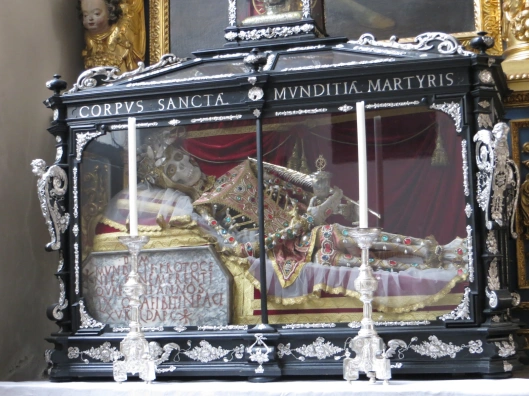 The Skeleton of Saint Munditia
The Skeleton of Saint Munditia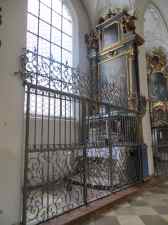 obscures it from view. Most visitors never notice she’s there, but those who catch a glimpse of her and pause to peer through the gate may be surprised to find a skeleton, bedecked in jewels and bound in gauze, staring back at them.
obscures it from view. Most visitors never notice she’s there, but those who catch a glimpse of her and pause to peer through the gate may be surprised to find a skeleton, bedecked in jewels and bound in gauze, staring back at them.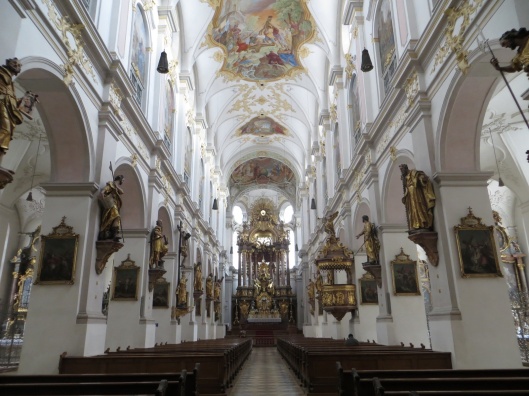
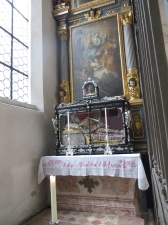 indicating Saint Munditia had been decapitated by an ax or hatchet. Others propose that “APC” stands for “ANDRONICO PROBO CONSULIBUS,” meaning “During the counsulship of [Tatius] Andronicus and [Pompeius] Probus.” Under this interpretation, Saint Munditia would have died in the year 310.
indicating Saint Munditia had been decapitated by an ax or hatchet. Others propose that “APC” stands for “ANDRONICO PROBO CONSULIBUS,” meaning “During the counsulship of [Tatius] Andronicus and [Pompeius] Probus.” Under this interpretation, Saint Munditia would have died in the year 310.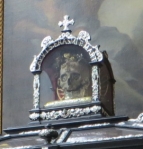 But Saint Munditia is not the only saint to share the small enclosure that contains her shrine. Above her glass ossuary and easily overlooked amidst the visual tumult of bones, jewels, and Baroque ornamentation surrounding her skeleton rests another, much smaller, glass reliquary. Peering out of the box with unnaturally blue eyes is a skull with a halo placed on a cushion. The inscription above it declares that it is the skull of Saint Erasmus: CAPUT S. ERASMI P. MART.
But Saint Munditia is not the only saint to share the small enclosure that contains her shrine. Above her glass ossuary and easily overlooked amidst the visual tumult of bones, jewels, and Baroque ornamentation surrounding her skeleton rests another, much smaller, glass reliquary. Peering out of the box with unnaturally blue eyes is a skull with a halo placed on a cushion. The inscription above it declares that it is the skull of Saint Erasmus: CAPUT S. ERASMI P. MART.